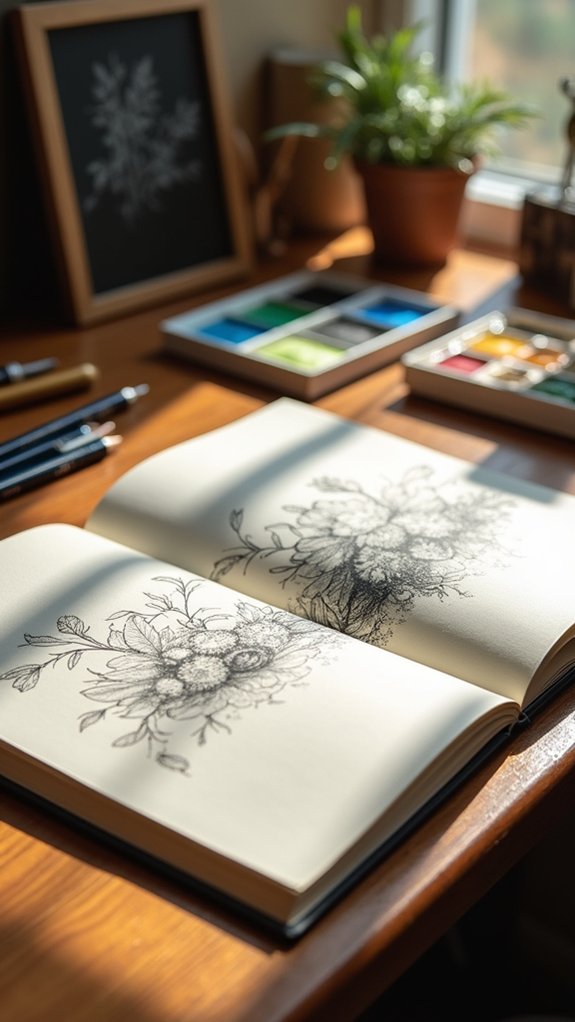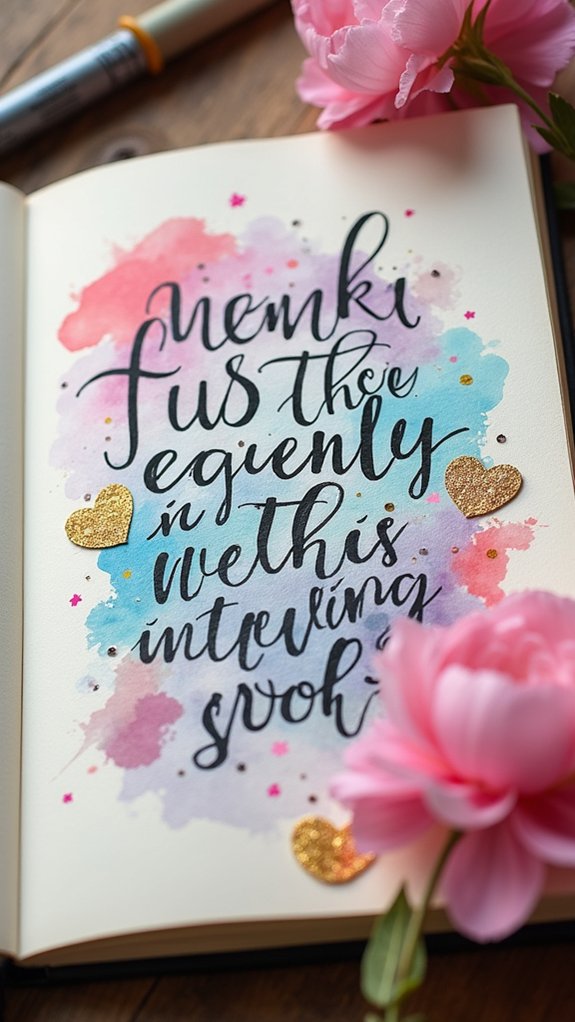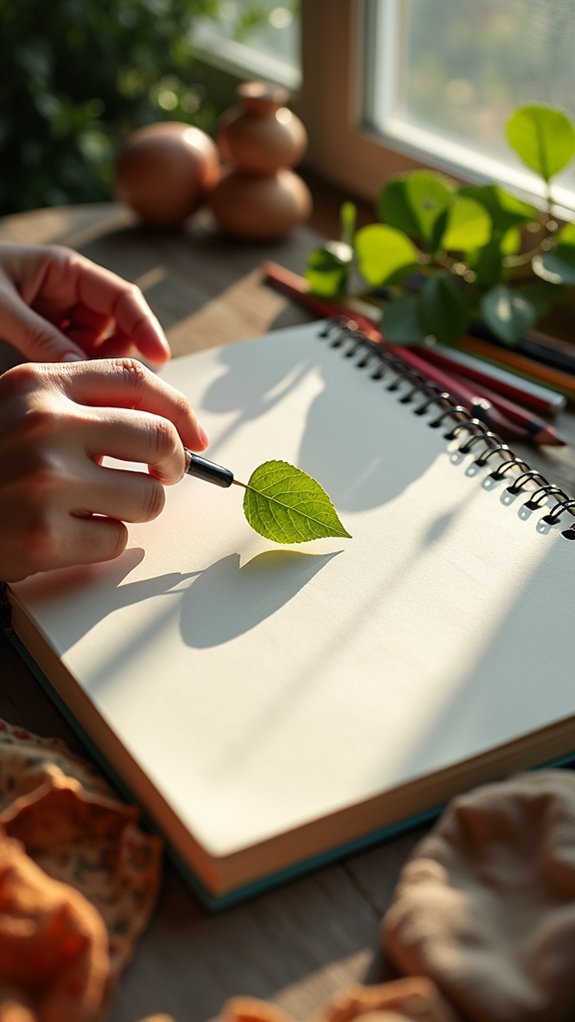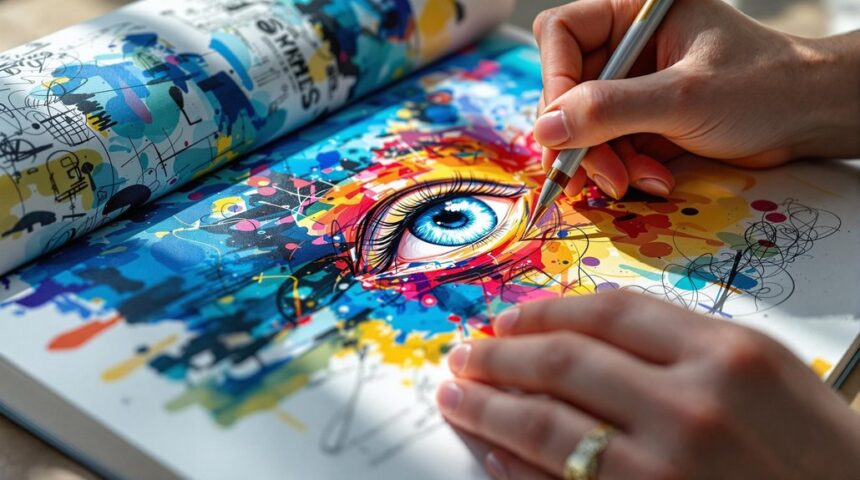To make your sketchbook’s first page unforgettable, start by letting go of that perfection pressure and just jump in—doodle, scrawl a favorite quote, or slap on a burst of wild color. Mix bold lettering with washi tape or even some old magazine bits for a personal vibe. Don’t stress if it gets messy; weird is memorable! Try balancing things with color blocks or sketchy boxes, and let some empty space give everything room to shine. The fun’s just getting started.
Key Takeaways
- Embrace imperfection by making your first mark—a doodle, quote, or experiment—instead of waiting for the “perfect” idea.
- Personalize the page with hand-lettered quotes and mixed-media elements like washi tape or patterned paper for extra flair.
- Use bold, limited color palettes and apply the rule of thirds or color blocks for dynamic composition and visual impact.
- Divide the page into sections for mini sketches, creative goals, or thumbnail brainstorming to invite exploration and reduce overwhelm.
- Choose quality materials, such as heavy paper and a comfortable size sketchbook, to enhance your creative confidence from the start.
Embracing the Blank Page: Mindset and Motivation
How does one even begin when that first crinkly page of a brand-new sketchbook stares back, daring someone to make the first mark? Honestly, starting a new sketchbook feels a bit like standing at the top of a diving board—exciting but terrifying!
But embracing the blank page is really about letting go of perfection. Creativity isn’t about always getting it right; it’s about giving yourself permission to make messy, weird, or even goofy stuff.
Sometimes, just writing your favorite quote or taping in a photo can break the ice. Small achievements, like doodling a pattern or simply drawing a blob, matter.
Over time, each mark turns into a milestone on your artistic journey, and that scary first page? It becomes something totally, beautifully unique.
Choosing the Right Sketchbook and Materials

Once that first-page nervousness is tackled, it’s time to think about which sketchbook and art materials can crank up the fun.
Finding the right sketchbook can actually make starting a new art adventure way more exciting—almost like picking out a cool new pair of sneakers before the first day of school.
Some artists swear by heavy paper weight, especially above 70 lbs, so they can use different colors and art supplies without worrying about bleed-through or wrinkling pages.
Others hunt for that “Goldilocks sketchbook”—not too big, not too small.
- Look for paper weight over 70 lbs for mixed media
- Medium-sized sketchbooks hit the sweet spot for most
- Try upcycling an old book for a totally unique twist
- Get honest opinions—sketchbook reviews really help!
Creative Ideas for Your First Page Layout
Even though that first blank page might look scary—almost like it’s daring someone to make the first move—a burst of creativity can transform it into something completely unforgettable.
Starting a sketchbook doesn’t have to mean staring at an empty page in panic! One great sketch tip and technique is to create a simple layout: divide the page into sections for mini sketches, art goals, or even a splash of color to add interest and energy.
Try jotting down a welcoming quote, slap on some bold colors, or sketch a tiny self-portrait. Small thumbnail sketches can serve as brainstorming corners, while creating a framework with boxes or circles makes things feel organized—not overwhelming.
Adding Personal Touches With Lettering and Mixed Media

Bold first pages are unforgettable, but what really brings them to life is when personal flair takes the reins.
Adding personal touches with a mix of cool lettering styles and striking mixed media elements transforms a simple first page into something truly yours. This step is all about getting creative—using inspirational quotes, different textures, and meaningful sketches or doodles that shout “this is me!”
Here are some ways to get started:
- Try hand lettering a favorite quote or mantra to set the tone for your artistic journey.
- Play with different lettering styles—think brush lettering, bubble letters, or even quirky calligraphy.
- Attach patterned paper, photographs, or washi tape as mixed media elements (use archival glue for lasting results!).
- Add small sketches or doodles that highlight your hobbies or big memories.
Using Color and Composition to Create Visual Impact
Color can be a game-changer when it comes to making your sketchbook’s first page pop, so picking a bold, eye-catching palette is a smart move.
It’s not just about wild colors, though—balancing where things go on the page, maybe using the rule of thirds or blocks of color, helps everything feel organized instead of a total art explosion.
With the right mix of colors and smart composition, your page can grab attention from across the room—no glitter explosions required.
Choosing a Striking Palette
Why do some sketchbook first pages seem to jump right out and grab your attention—while others fade into the background? The secret is in choosing a striking palette that instantly creates visual impact.
Instead of using every color in the rainbow, artists who start strong usually pick a limited color palette, usually 3-5 colors that complement each other. This helps set the mood and keeps things looking cohesive, not chaotic.
- Pick 3-5 shades that create a bold, limited color palette so everything pops together.
- Use contrasting colors (like blue and orange) to spotlight your coolest details.
- Try blending or layering your colors to add surprising depth and texture.
- Mix in lighter and darker versions of your chosen shades to keep eyes from getting bored.
With the right palette, your first page can’t help but stand out!
Balancing Elements Effectively
Having an awesome color palette is a great start, but what really makes that first page stick in someone’s memory is the way everything works together on the paper. A carefully chosen color palette should pop, but don’t just splatter colors everywhere—balance them! Try using only two to four main colors for harmony, letting key parts really stand out. The rule of thirds? It’s not just for photographers—placing your drawings off-center can create maximum visual impact. Play with thick and thin line weights to add drama and guide the eye. And don’t forget about negative space; leaving empty spots can actually make your art look bolder and more interesting. Here’s a handy quick-look table for balancing your first page:
| Tip | Why It Works |
|---|---|
| Use bold color palette | Instantly grabs attention |
| Play with line weights | Adds depth and focus |
| Rule of thirds | More dynamic layout |
| Limit colors | Keeps things harmonious |
| Use negative space | Highlights key elements |
Building Consistency and Setting a Theme for Your Sketchbook

Even though the first page of a sketchbook can feel like a huge, white mountain just waiting to be climbed, things get a lot easier when there’s a theme guiding the way.
Picking a theme transforms that first sketchbook page into the start of a cool adventure—whether it’s “fantastical creatures,” “city rooftops,” or even “food doodles.”
Consistency matters too. When an artist sets aside regular time and energy for their sketchbook, that’s when creative expression really explodes (in a good way, not like a soda can in the sun).
To help make the most of every page, try:
- Keeping a date log to track progress and memories
- Celebrating little wins, like finishing a new technique
- Letting the theme evolve over time
- Treating sketch time as a special appointment
Frequently Asked Questions
What Should I Do on the First Page of My Sketchbook?
When considering the first page of a sketchbook, one might incorporate inspirational quotes, a personal mantra, thoughtful page layout, artistic goals, and favorite colors. These choices can encourage creativity while establishing a meaningful and motivating introduction.
How Do You Start Your First Sketchbook?
Starting a first sketchbook often involves establishing sketchbook beginnings through personal expression, creative rituals, and setting intentions for the artistic journey. Many overcome fear by choosing familiar subjects or inspirational words, fostering confidence for continued exploration.
What Should I Draw on My First Page?
When considering what to draw on a first sketchbook page, one might include inspirational quotes, personal symbols, or favorite colors. Dream scenery and artistic goals could also be illustrated, establishing a unique and motivating creative foundation.
How Can I Make My Sketch More Interesting?
When considering how to make a sketch more interesting, one might employ creative techniques like color experimentation and mixed media, incorporate inspirational quotes, and explore thematic concepts, thereby enhancing depth, visual intrigue, and conceptual engagement within the artwork.
Conclusion
So, the first page of a sketchbook doesn’t have to be scary—it can totally be your creative superpower. Whether you splash on some wild colors, doodle your name in crazy lettering, or just write why you love to draw, it’s all about making it yours. Don’t worry about being perfect. Even if you mess up, that’s part of the fun! Every first page is really just the start of an epic art adventure.


Leave a Reply